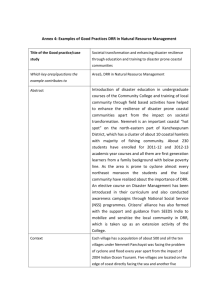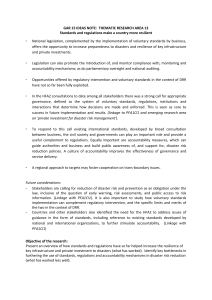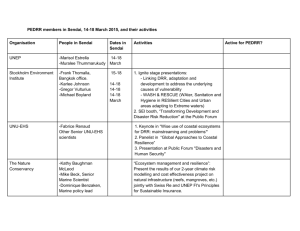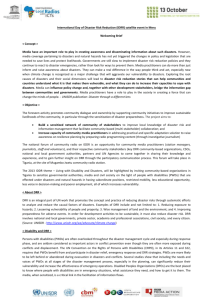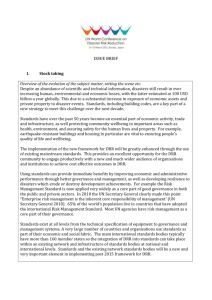BUTIR WICARA
advertisement
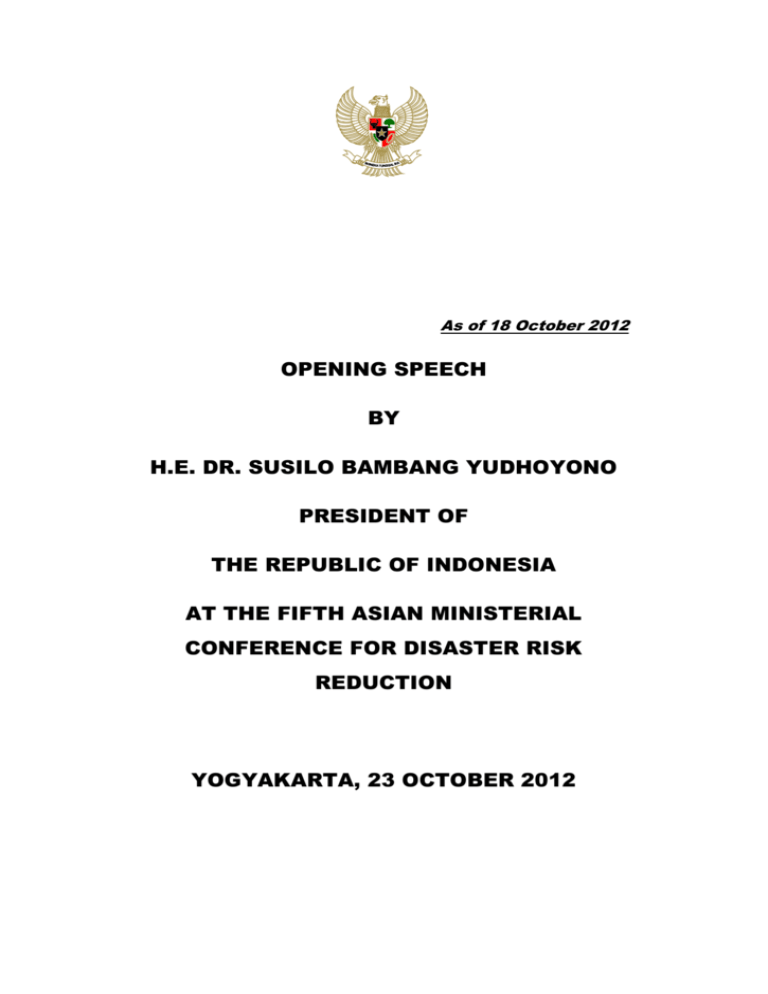
As of 18 October 2012 OPENING SPEECH BY H.E. DR. SUSILO BAMBANG YUDHOYONO PRESIDENT OF THE REPUBLIC OF INDONESIA AT THE FIFTH ASIAN MINISTERIAL CONFERENCE FOR DISASTER RISK REDUCTION YOGYAKARTA, 23 OCTOBER 2012 1 Bismillahirrahmanirrahim, Assalamu’alaikum warahmatullahi wabarakatuh, Peace be upon us all, Salam sejahtera untuk kita semua, Excellencies Ministers of Asia and the Pacific countries, Honorable Governor Yogyakarta, of Special Region Excellencies Ambassadors and Representatives of United Nations Agencies and International Organizations, Distinguished Delegates and Guests, Ladies and Gentlemen, 2 First of all, I am delighted to welcome all of you to Yogyakarta—a city that is rich in culture and history. It is indeed a pleasure for Indonesia to be selected as the venue for this year's Asian Ministerial Conference. important Conference Hosting has such added an new significance to our efforts at national and regional levels. Nationally, Indonesia is now working hard to accelerate our capacity in disaster management. And at the regional level, many of our regions, including Yogyakarta, are making efforts in building disaster risk reduction capacity. Therefore, I consider the theme for this conference: “Strengthening Local Capacity for Disaster Risk Reductions” very timely. Indeed, 3 the need to strengthen local capacity in reducing disaster risks is now becoming highly critical. It also makes Yogyakarta the right place for this conference. This Special Region is under constant threat of volcanic eruption. It was hit by an earthquake in May 2006—claiming more than 5,000 lives, and damaging more than 150,000 houses. Now Yogyakarta is recovered, and continues to build its disaster resilience capacity. Ladies and Gentlemen, Along with many natural disasters that struck many countries, disaster risk reduction (DRR) has become increasingly important. I attach great importance to efforts in increasing DRR capacity to minimize vulnerabilities and disaster risks. In the case of Indonesia, this is 4 also critical to help ensure sustainability of our development efforts. It is encouraging that at the international level, we have the Hyogo Framework for Action 2005 – 2015. Indonesia attaches particular importance to this Framework. It serves as a main point of reference in devising our National Plan of Action on DRR, including its programs. Through the implementation of the Framework and the Plan of Action, we have taken a number of measures to promote DDR. We have made DRR a priority in our disaster management strategy. We include in this strategy schemes to increase resilience and partnerships at the national, regional and global levels. 5 Indonesia has also revitalized its institutional capacity by establishing the National Agency for Disaster Management (BNPB) in 2008. At the provincial established the and Local Agency (BPBD). district levels, Disaster we Management In addition, we have also initiated DRR forums and platforms at the national and local levels. Successful DRR efforts will also need sufficient legal foundation. In the case of Indonesia, the Government in collaboration with the Parliament has produced Law No. 24 on Disaster Management in 2007. Coherence and coordination in the implementation of this Law is important. Hence, I am glad that relevant ministries and local governments have issued a number of implementing regulations. 6 I am aware that no country can do its DRR efforts alone. Therefore, Indonesia promotes bilateral, regional and international partnerships to build up its DRR capacity. Bilaterally, Indonesia has developed partnerships with a number of countries. These include Australia-Indonesia Facility for Disaster Reduction (AIFDR). Under ASEAN framework, we collaborate Disaster through Management ASEAN and Committee ASEAN on Regional Forum Disaster Relief Exercise (DIREx). At the international level, Indonesia works closely with the United Nations Office for Disaster Risk Reduction, in particular in realizing the Hyogo Framework for Action. Indonesia believes that DRR is essential to sustainable development. It helps save and 7 preserve the achievements of our development efforts. It helps mitigate the destructive effects of natural disasters on physical materials as well as social and economic infrastructures. This is the reason behind my Government’s decision to integrate DRR into our Mid-term National Development Plan 2010 – 2014. DRR is also critical to our efforts in realizing the vision: “Towards Indonesia's Resilience to Disaster”. The threat of natural disasters in Indonesia is enduring. This is because, as you all are aware, Indonesia sits between the world's most active seismic and tectonic regions — the Pacific 'Ring of Fire' and the Alpide Belt. Thus, we are situated in one of the most volatile regions in the world. 8 The Indian Ocean Tsunami on the boxing day of December 26, 2004, was a wake-up call for Indonesia on the importance of having disaster resilience. And hopefully, through DDR, Indonesia will be able to attain that resilience. Ladies and Gentlemen, Today, according to the World Disaster Report 2012, more than one hundred local areas throughout Asia are prone to natural disasters. When natural disasters hit, it is the local people who are hurt first and the most. It is the local governments that have to first tackle the challenges in their aftermath. Indeed before the central government can lend their hands, it is the local governments which must respond first. 9 Therefore, it is important that we strengthen their capacity for DRR. And, this is the reason why my Government placed local capacity building a top priority. Through our national agency, we have developed an Indonesia Disaster Risk Index (IDRI). We developed inventory of hazards, vulnerabilities, and capacities of all local governments. Out of 494 districts, we identify areas that fall into high, medium, and low risk zones. It is disheartening to mention that 396 districts are situated in high risk zones and they are highly vulnerable to various types of disasters. Now, I would like to share a few thoughts on how we can strengthen local capacity for DRR. 10 FIRST, local resilience can be acquired through the development of disaster resilient villages. It is in villages that we mostly witness the devastating Earthquake, effects of tsunami, natural landslide, disasters. volcanic eruption, and flood have often damaged most parts of rural areas. In the archipelagic context like Indonesia, natural disasters affect both coastal and inland villages. We adjust our DRR initiatives to the geographic characteristic of our villages: Kampung Siaga (Prepared Villages) for inland areas and Desa Pesisir Tangguh Coastal Villages) for coastal areas. (Resilient 11 These disaster resilient villages serve the objective of creating community-based DRR at the local level. These villages can be part of wider networks for the implementation of DRR plans and strategies. In my opinion, these villages can also serve as a basis for the development of risk management governance at the local level. And in order to be viable, this governance must underline flexibility in the decision-making and the empowerment of communities. It must also include local actors and take into account local values. This leads me to my SECOND point, that participation of multi-stakeholders is critical to local capacity for DRR. 12 DRR is a collective responsibility of governments and the people, both at national and local levels. Therefore, Indonesia has encouraged the participation of all stakeholders to support the strengthening stakeholders academia, of include local capacity. civil society professionals, These groups, parliamentarians, religious leaders, and even business community. I am glad that representatives from those stakeholders are here among us today. I invite you to contribute more to the efforts in strengthening the local capacity for DRR. I also attach particular importance to partnership among stakeholders. Therefore, on the occasion of the World Economic Forum on East Asia Summit in 2011, I launched the Disaster Resource Partnership (DRP) National Network for 13 Indonesia. And on January 27, 2012, my Government, in cooperation with engineering and construction companies, formed a Disaster Management Partnership Network. THIRD, human capacity and technical capacity at the local level need to be developed. Human capacity includes knowledge, expertise, and wisdom. It is important that local communities are aware of the potential dangers posed by natural disasters to their areas. It is important that they have courage to appreciate the importance of having readiness to face natural disasters. We need to beef up indigenous knowledge that proves effective in the past to anticipate natural disasters and mitigate their impacts. 14 Local communities generally have multiple methods to manage disasters. But their methods can be made more effective if we incorporate upto-date ways and best practices in disaster management. We can combine local methods and more developed technical skills to make the local communities more resilient. In view of this, Indonesian government pays great attention to enhancing community technical and organization capacity and community empowerment. We pursue this objective through dissemination of knowledge and skill enhancement. FOURTH, financing is critical to achieving local capacity for DRR. 15 In my view, local community must have sufficient financing to support its disaster resilience capacity. One of the ways to obtain financing support is through public-private partnership in promoting investment in social and physical governments local also can infrastructure. establish Local contingent budget as sustainable reserve. Another potential sources for funding are philanthropic organizations. The world is never finite with people who have abundant interests in lessening the burden of victims of natural disasters. It is therefore natural if we invite them to support DRR financing. FIFTH, there must be coherence between national capacity and local capacity. National action plan must strengthen local action plan. It 16 must help local actors develop local DRR programs. This coherence is important because, in my view, resilience at the national level and that at the local level are mutually reinforcing. If I may use an insight from one reference document of this conference, I would say: like a tree and its roots, the national level is the roots. The community level is the leaves. And the branches represent the administrative levels that connect it all together. And SIXTH, I believe that it is important to integrate small-scale DRR and climate change adaptation (CCA) initiatives into local development processes. It is also important to 17 integrate local DRR and CCA initiatives into the national development planning. To support the implementation of DRR and CCA programs at the local level, funding mechanisms can be established at the national level. In my view, well-funded local programs are critical to target the most vulnerable. Ladies and Gentlemen, Before I conclude, let me touch on the issue of DRR from the perspective of the post-2015 development agenda. As you might all be aware, I have been tasked by UN Secretary-General Ban Ki-moon, together with President Ellen Johnson-Sirleaf of Liberia and Prime Minister David Cameron of the United Kingdom, to Co-Chair the UN High-Level 18 Panel of Eminent Persons on the Post-2015 Development Agenda. The Panel has met in New York in September 2012, and we will meet again in London next month. I am glad that there was a common view in the Panel during the first meeting on the importance of factoring in natural disasters in development agenda. The Panel viewed that natural disasters and other crises could push millions of people back into poverty. The Panel also underlined that we must safeguard the MDGs gains from setbacks caused by natural disasters and climate change. As a country that is prone to natural disasters, Indonesia has commitment to ensure 19 that the post-2015 development agenda take into account the natural disaster dimension. I also recognize that the Hyogo Framework for Action will end in 2015. I am glad that consultative process towards post-2015 Hyogo is on the way. In this regard, I hope this Conference could also contribute to this process, and to the post-2015 DRR agenda. I am glad to learn that the Conference will produce the Yogyakarta Declaration and Plan of Action. I hope these documents will guide us in our efforts to further enhance local capacity for DRR in the future. As a final note, I am fully aware that discussing disasters are surely stressful and highly demanding. I, therefore, urge you to relieve 20 your tension by exploring the ancient city of Yogyakarta. And of course, after the Conference. And now, by saying, Bismillahirrahmanirrahim, I declare the 5th Asian Ministerial Conference for Disaster Risk Reduction officially open. May the outcome of this Conference bring benefits to all of us. Thank you.



